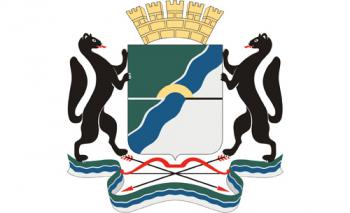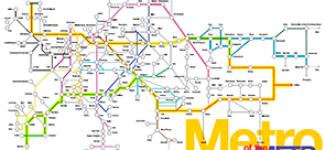Home › Projects › White Book › Enhancement of Mobility Quality in Novosibirsk and Integration into the International Network of Transport Corridors
Enhancement of Mobility Quality in Novosibirsk and Integration into the International Network of Transport Corridors

Today, as never before, there is a growing need for cementing the cooperation, increasing cohesion and unity within the whole of Eurasian region. The project “METR Region’s Metro (Middle East, Europe, Turkey, Russia): Region’s Future Mobility” will provide new opportunities for involving the cities into Eurasian transport integration through establishment of shared high-speed railway space. The new rail Silk Road is not just a transportation concept. The project aims to shape a unique system of interaction, exchanges, links and transporting of people and ideas.
In particular, this project also relates to the West-Siberian region with Novosibirsk at its center. The city is already involved in Eurasian logistics and transportation due to its geographical position. It may and will further develop as a hub within the international network of transport corridors. Novosibirsk is set on searching for new resources, scenarios and means of interaction with various cities within the METR region. The city’s involvement in implementation of international transport and infrastructure projects may, undoubtedly, be considered as one of the major conditions for improvement of its recognition, investment attractiveness and development.
Novosibirsk – Gateway to Asia
In geopolitical sense Novosibirsk is a transport gateway to Asia. The city possesses a sum of advantages that makes it unique in Russia east of the Urals. Novosibirsk links Siberia, the Far East and Central Asia to the country’s European regions. It is the largest hub of transport and logistics that advantageously sits on the intersection of railway, motor, air and water routes. It is home to Tolmachevo international air hub, which is the largest one in the eastern part of Russia; the largest Siberian railway hub with the Trans-Siberian Railway passing through it; the navigable Ob river and a river port.
Novosibirsk is intersected by major trade routes (Central Asia, South East Asia, Russian North, the Far East, Europe). Regional warehouses and representative offices of global trade companies are headquartered in the city. Novosibirsk is the economic hot spot for the vast adjacent territory. There are 20 million residents within the area of its influence with the radius of 1,000 kilometers. Novosibirsk means logistics and transport, medical and pharmaceutical industry, defense industry and IT, business and financial activities. These are the branches that are effectively developing in the city and are not dependent upon availability of natural resources.
Integration of Novosibirsk into the international network of transport corridors, and its transformation into one of the stations within the Eurasian metro system will be a logical and natural stage of its development. To take this important step the authorities will be required to make key decisions for enhancement of mobility quality in the city. Mobility implies creation of highly organized network of motor- and railroads, efficient operation, comfortability and appeal of public transport.
Need for Strategic Transport Planning
The need for development of new approaches to solving transport problems has been urgent in Novosibirsk for some time already. Like many other large cities in the West and Asian Pacific Region Novosibirsk has faced challenges that arise from rapidly growing number of personal vehicles and active housing construction, namely, traffic congestion. In the city of 1.5 million people over 1,700,000 square meters of housing were commissioned in 2015 alone, which again put Novosibirsk ahead of other Russian cities with the population of over a million people. Building development projects have been designed faster than transport corridors were provided. As a result, the scope of housing construction overwhelmed the capacity of the existing road network.
Best practices prove that solution of transport mobility problems should include development of public transport and instruments for restriction of private transport use, especially in densely developed central city districts. Compensatory development of public transport should bring advantages to the passengers in terms of speed, safety, comfort and economic reasons. An efficient transport framework for urban development should be created. It should include route plans based mainly on rail transport routes, feeder routes, transfer hubs, parking spaces and interceptive parking lots.
Being aware of the necessity of strategic transport planning, the local authorities of Novosibirsk have chosen a comprehensive approach to enhancement of transport mobility in the city. The Concept of Public Transport and Transport Infrastructure Development in the City of Novosibirsk for 2015-2020 have been created.
The Concept sets key priorities, including development of green transport, above all, subway and electric transport. Another priority is expansion and optimization of public transport route network, as well as replacement of shuttle vans with large-capacity urban buses. Simultaneously, it plans for further development of transport infrastructure, including establishment of transit hubs with regard to compatibility of all types of urban and commuter rail transport. It also plans for improvement of fare system in urban public transport.
Multimodal Transport Model as a Tool for Transport Network Development
A multimodal basic transport computer model of Novosibirsk developed by the Siberian State Transport University has become one of the tools to implement the Concept. This tool helps to forecast the results of developing new areas, erecting new buildings, adding new infrastructure elements and altering traffic arrangement.
The city’s comprehensive traffic map, which includes the public transport route map, complete data for passenger flows and the method for online simulation of traffic conditions, has been refined in 2015 with the help of the transport model. The existing transport stops have been reviewed. Public transport stops have been catalogued with reference to the coordinate system. Traffic maps for individual types of public transport have been designed. As a result of comprehensive examination of the passenger and traffic flows, passenger flows with regard to specific public transport stops and the people’s travel correspondence, the transport accessibility map has been made.
The modelling made it possible to formulate proposals to optimize the route map. A prospective map of tram routes for the city’s left-bank districts has been designed. A number of infrastructure elements of that map have already been commissioned. In 2014 and 2015 tram hubs that provide direct transportation to subway stations have been modernized in the left-bank part of the city. In 2016, upon completion of a tram line from a remote south-western residential district, its residents will be able to get to the Karl Marx subway station using public transport and avoiding traffic jams.
This modelling method was also used to calculate rerouting of passenger flows. In 2015 a qualitative balance between large-capacity passenger vehicles and shuttle vans was reached. Large-capacity buses have been given priority, while the number of shuttle vans that overcrowded public roads has been almost halved to become optimal.
Public Transport in High Priority
The City of Novosibirsk continues to introduce bus-only lanes for public transport. After a bus-only lane has been introduced in the city’s main thoroughfare, Krasny Prospekt, the public transport’s speed on that stretch of the road increased, while the number of traffic accidents fell. In 2016 it is planned to introduce new bus-only lanes in two more thoroughfares – Bogdana Khmelnitskogo st., and Dusi Kovalchuk st. This will make it possible to decrease travel time to the transit hubs (Zaeltsovskaya subway station) from large residential districts in the eastern and north-eastern parts of the city. However, it is still difficult to create a uniform bus-only lane throughout the city, because the width of overpasses won’t allow it.
At the same time, Novosibirsk faces an important task of how to find incentives for the residents to choose public transport. Economic incentives (fares), as well as comfort, convenience, safety and speed will be the solution.
Thus, in 2016 the city has launched the upgrading of fare system in the municipal surface transport. Novosibirsk was one of the first Russian cities to introduce cashless payments in public transport almost 10 years ago. Today, almost 460 thousand residents (close to the third of Novosibirsk population) use transport cards to pay their fares. Over 15 million rides are paid for with transport cards monthly, which is over 50% of all the monthly rides.
However, there has been a long-standing need to improve this system. By the end of the year 2016 it is planned to introduce new hi-tech consoles in all passenger vehicles. Since February 2016 such consoles have been introduced in municipal surface public vehicles (trams, buses, trolley-buses).
Apart from recording a ride such consoles can print receipts indicating all necessary information about the carrier, as well as the card’s remaining balance, which is very useful for a passenger. And most importantly, upgrading of the cashless fare payment system will make it more transparent and will help to efficiently control financial flows. Also, such upgraded system will make it possible to monitor efficiency of the public transport (e.g. compliance with route schedules), as well as measure the passenger flows online.
It is worth noting, that in order to encourage passengers to use cashless fare payment system it will be necessary to set differentiated fares with regard to the payment method. Eventually it is planned to introduce a universal travel card.
Besides, in 2016 the City of Novosibirsk is planning to launch the system of contractual obligations, meaning that carriers will be paid for the actual runs in compliance with their schedules, and not for the overall presence of their vehicles on the routes. The municipal contractual system will help settle the problem of passenger transit in the evenings, when carriers avoid making late runs due to the shortage of passengers. It will also make it useless for the public transport to idle at transit hubs in order to get more passengers and gain extra profit. The definition of high and low profit routes, depending on the number of potential passengers, will also be rendered useless. The contractual system will ensure sustainable transport accessibility of remote city districts. Upgrade of the cashless fare payment system, which is one of the instruments of the new method of payment to the carriers, will allow paying the carriers for the actual transportation.
Paid Parking: Problems and Goals
Provision of parking space is a critical issue in Novosibirsk. Today, various options for finding a solution to this problem are being considered, including the positive experience of Moscow, which succeeded in fighting chaotic parking and traffic congestion. A draft system of the universal paid parking space has been designed, which plans for creation of a network of CCTV-monitored parking lots to be used by car owners and paid for in several ways.
When designing a map of paid parking lots in Novosibirsk it will be necessary to take into account peculiarities of the urban territory and traffic. In particular, the Ob river determines the urban layout. Just several thoroughfares, mainly Krasny Prospekt, take the main burden of traffic flow. The network of the paid parking lots will be launched stage by stage, starting with the busiest areas.
Besides, it will be necessary to help the residents realize that they will now have to pay for parking their cars where they had previously parked them for free. But in the end they will have to understand that the local authorities consider launching the paid parking lots network as a means of controlling traffic flows through Novosibirsk, and not as a means of increasing the municipal budget.
Construction of large-scale road infrastructure facilities
Construction of large-scale road infrastructure facilities, multi-level junctions and the third motor bridge across the Ob river boosted the development of transport network in the city. Bugrinsky Bridge is justly considered one of Russia’s megaprojects. Today it is the largest arched bridge in the nation. It improved transportation between the two river banks, along which Novosibirsk is situated, dispersed traffic flows and made it possible to reroute some of the traffic from western direction eastward. In the course of the bridge’s construction the adjacent areas have also started developing. Land lots along the new junction gained in value.
In the future it is planned to incorporate Bugrinsky Bridge and adjacent roads into the large-scale South-Western Bypass project. It will help link it with the Eastern Bypass, which is currently under construction, and gain access to M-52 Federal Motorway and Gusinobrodsky Highway on the one hand, and access M-51 Federal Motorway and Tolmachevo International Airport on the other hand.
Rail Commuter Service and Tolmachevo Hub: Regional Integration
Development of rail commuter service is an important integral part of enhancing the public transport’s efficiency. In Novosibirsk the railroad is being closely integrated into the city’s transport infrastructure. Thus, a new Seyatel Rail Station has been commissioned in 2015 after a lengthy renovation. It basically serves as an above-ground subway station for the residents of Sovetsky district, who spend significantly less time in traveling downtown and back thanks to the railroad. This renovated transit hub has improved transportation in the southward direction, which is one of the busiest traffic routes in the city.
Russian Railways implemented a large-scale breakthrough project of launching high-speed train operations with Barnaul and Tomsk. Essentially, it represents continuation of expansive integration process, which, in particular, includes transportation of passengers from Barnaul, Tomsk and Omsk, whose destination is Tolmachevo International Airport. This project has linked the whole of Siberian rail network with aviation facilities. It opened up new opportunities for serving not only passengers from the Novosibirsk metropolitan area, but also from nearby regions that are within Novosibirsk’s area of influence.
Tolmachevo Airport is turning into not only a transit point, but also a global hub of cargo-handling, shipping and logistics. Last year the Airport commissioned a new terminal for servicing intensive international flows. A strategy for development of the Tolmachevo air hub as a large regional and international aviation hub is being implemented, which will turn it into one of the elements of the global shipping logistics.
By developing large-scale transport and infrastructure projects Novosibirsk lays a foundation for renovation, innovative path of development and economic growth. Enhancement of mobility quality will enable the city to smoothly become a part of the Eurasian integration process and become a full-fledged player in the international network of transport corridors.
http://www.kommersant.ru/doc/2979278
Sign up for MIR initiative email updates
Sign up to receive monthly notifications about new arctiles published and other events on your email.






